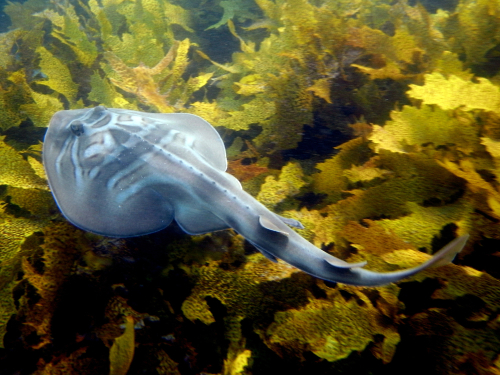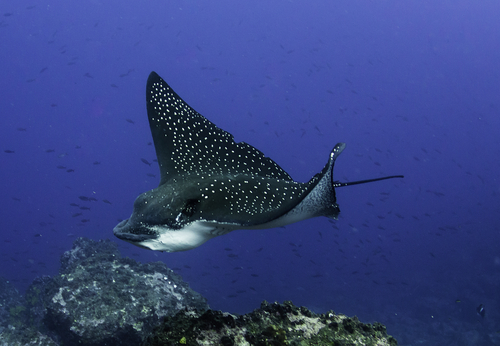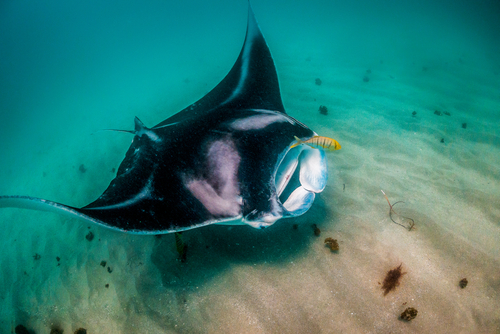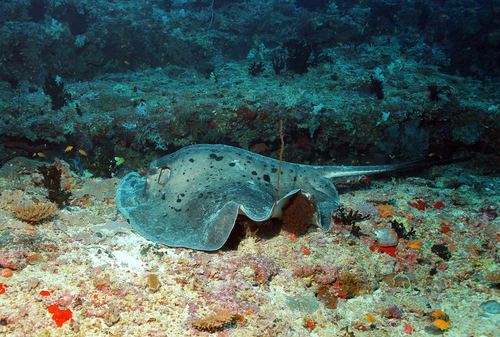Stingrays are cartilaginous fish that are found all over the world, in different parts of the Earth’s oceans. Currently, there are over 220 species of stingrays in existence.
Interestingly, there are many other fish out there in the world’s oceans that resemble a stingray. Some of these include the fiddler ray, spiny butterfly ray, cownose ray, spreadfin skate, roundel skate, barndoor skate, and bluespotted ribbontail ray.
Read on to learn more about popular fish that look like a stingray and find out some interesting facts about them. Happy reading!
Contents
Popular fish that look like a stingray
Here is a list of over 15 popular fish that look like a stingray. Many of these fish have a similar shape and are also comparable in terms of size to the stingray.
Also see other similar posts:
- Popular Black Fish With White Spots
- Popular Fish That Look Like A Dog
- Popular Fish That Look Like Eels
- Popular Fish With Yellow Stripes
1. Fiddler ray

- Scientific name: Trygonorrhina
- Diet: worms, crabs, shellfish, and crustaceans
The fiddler ray is a fish that looks like a stingray. These fish are typically found off the southern and eastern coasts of Australia. The body of a fiddler ray has a disc-like shape and greyish or brownish color. They also have slender tails and two dorsal fins that are triangular in shape.
Fiddler rays are commonly found in shallow waters, with depths ranging from 120 to 180 meters. They can be found in seagrass beds and rocky reefs.
2. Spotted eagle ray

- Scientific name: Aetobatus narinari
- Diet: feed primarily on crabs, shrimp, mollusks, octopi, and small fish
The spotted eagle ray is another fish that looks like a stingray. It has a distinct appearance, with a kite-shaped body and a long tail. The body of the spotted eagle ray has a deep red background, with several white spots and rings on it.
The ray also has several barbed stingers near the bottom of its tail that can release venom.The spotted eagle ray can grow up to 5 meters in length and 3 meters in width.
Larger adults can weigh over 200 kilograms. The spotted eagle ray is found in tropical waters throughout the world, including the Indian, Atlantic, and Pacific oceans. It is usually found in coastal waters in these regions, at a depth of around 80 meters.
3. Cownose ray

- Scientific name: Rhinoptera bonasus
- Diet: oysters, clams, mollusks, and crustaceans
The cownose ray is yet another fish that looks like a stingray. The fish is found in the Atlantic Ocean, from the northern United States to southern Brazil.
Cownose rays have an average width of just over 1 meter. Males are usually smaller than females. The largest cownose ray that has been recorded was over 2.1 meters in width.
The head of a cownose ray resembles a cow’s nose because of which it got its name. The back of the fish is typically brown in color, whereas the belly is white/yellow.
4. Bluespotted ribbontail ray

- Scientific name: Taeniura lymma
- Diet: worms, crabs, shrimp, clams, and some small fish
The bluespotted ribbontail ray is yet another fish that looks like a stingray. It has a very distinct appearance, with its pectoral fin having a yellow-brown color with neon blue spots on it.
The bluespotted ribbontail ray is typically found in the Indo-Pacific waters, in the coastal waters of many African and Asian countries. This fish is small and has an average width of 35 cm. It is typically found at a depth of 30 meters.
5. Bat ray

- Scientific name: Myliobatis californica
- Diet: typically feeds on a variety of crustaceans, mollusks, and some small fish
The bat ray is a type of eagle ray found in the coastal waters off the western coasts of the United States and Mexico. The bat ray is also found in waters around Galapagos Island. Large bat rays can have a width of up to 1.8 meters.
A bat ray has distinctive pectoral fins that are shaped like a bat’s wings.
6. Giant manta ray

- Scientific name: Mobula birostris
- Diet: invertebrates, shrimp, plankton, and small fish
The giant manta ray is the largest species of ray in the world. The fish can grow up to a whopping 9 meters in length and have pectoral discs up to 7 meters wide.
The average weight of a giant manta ray is about 2000 kg. It is found in tropical, subtropical, and even temperate waters sometimes throughout the world.
The skin of a giant manta ray is smooth and its upper surface has a dark brown or black color. The underside of its body is usually pale white.
7. Lesser electric ray

- Scientific name: Narcine bancroftii
- Diet: worms, sea anemones, small fish, and different crustaceans
The lesser electric ray is a type of electric ray found in the shallow waters of the western Atlantic Ocean, near the coasts of southeastern North America. It is particularly found in the Caribbean Sea and the Gulf of Mexico.
The lesser electric ray has a dark-brown or orange/red body that has an almost circular shape. It also has a dark pattern of rings on its body of various sizes.
On average, it can grow up to 45 cm in length and 20 cm in width. Its electric organs can generate a voltage of up to 37 volts to stun prey and scare off predators.
8. Blotched fantail ray

- Scientific name: Taeniura meyeni
- Diet: feeds on bottom-dwelling fish, crabs, shrimp, etc.
The blotched fantail ray is a large fish that looks like a stingray. It is commonly found in the western and eastern Indian Ocean and the western Pacific Ocean near the coast of Australia. This species of the ray is a large fish that can reach up to 1.8 meters in width.
The blotched fantail ray has a large, wide pectoral disc that is rounded at the edges. Its body is green in color and has dark blotches on it. The tail of the blotched fantail ray is of medium length, being slightly longer than its pectoral disc.
9. Common torpedo

- Scientific name: Torpedo torpedo
- Diet: typically feed on bony fish, skates, crustaceans, and invertebrates
The common torpedo is a species of the electric ray family that is found in the eastern Atlantic Ocean and the Mediterranean Sea. It can grow up to 60 cm in length and has a pectoral disc that is nearly circular in shape. The common torpedo’s tail is thick and short.
Since the common torpedo is an electric ray, it can deliver a powerful electric shock of almost 200 volts to attack prey and defend itself from predators.
10. Australian bull ray
- Scientific name: Myliobatis australis
- Diet: feeds usually on crabs, worms, and mollusks
The Australian bull ray is another fish that looks like a stingray. This ray is found primarily in the waters off the southern coast of Australia. It is typically found in shallow waters but also inhabits deeper waters at a depth of 85 meters.
The Australian bull ray can grow up to 1.2 meters in width and the width of its pectoral disc is greater than the disc’s length. The upper surface of the ray is dark brown or olive green whereas the ventral surface is white or gray.
11. Spreadfin skate
- Scientific name: Dipturus olseni
- Diet: small fish and marine invertebrates
The spreadfin skate is a deep-water skate found in the western Atlantic Ocean, near the southeastern coasts of North America. The fish is usually found at depths ranging from 55 to 380 meters. Spreadfin skates can grow up to 60 cm in length.
The spreadfin skate has triangular pectoral fins, thin tails, and pointy snouts. The pectoral fins are dark brown in color on the top and darker on the underside.
12. Roundel skate
- Scientific name: Rostroraja texana
- Diet: smaller fish, shrimps, crabs, and other crustaceans
The roundel skate is also known as the Texas clearnose skate and is typically found in the Gulf of Mexico, off the southeastern coast of Florida, and near the northern coast of the Yucatan Peninsula.
These fish have an average mature length of over 50 cm and are found at depths of 180 meters.
The roundel skate has a diamond-shaped pectoral disc that has a mostly dark-brown color. The skin on either side of its snout is clear and colorless.
13. Barndoor skate
- Scientific name: Dipturus laevis
- Diet: carnivorous in nature, feeds on smaller, bottom-dwelling fish and invertebrates
The barndoor skate is a large species of skate found in the northwestern Atlantic Ocean. The fish can grow up to a length of 1.5 meters and is one of the biggest species of skates that live in the northern Atlantic Ocean.
The barndoor skate has a distinctive shape, with a pointy snout and a pectoral disc with angular corners. The upper part of its pectoral disc is reddish-brown in color, with dark spots scattered on it. The underside of the fish is typically gray or white.
14. Rosette skate
- Scientific name: Leucoraja garmani
- Diet: crustaceans, squids, and small fish
The rosette skate is a smaller species of skate that can grow up to 45 cm in length and 26 cm in width. This fish is found in the western Atlantic Ocean, near the coast of the United States, from Florida to Massachusetts. The rosette skate inhabits deep waters, ranging from 590 to 5900 meters in depth.
The pectoral disc of the rosette skate has rounded corners and a dark red upper surface. The skate also has a long tail, which is longer than its body.
15. Atlantic guitarfish
- Scientific name: Pseudobatos lentiginosus
- Diet: small fish, mollusks, shrimp, and other crustaceans
The Atlantic guitarfish is a type of guitarfish that is found primarily in the coastal waters of the western Atlantic Ocean. Like most guitarfish, the Atlantic guitarfish shares physical characteristics with both sharks and rays. It has a long body with small wings and a thick, long tail.
This fish can grow up to 78 cm in length. The color of the Atlantic guitarfish’s body is grayish brown with small white spots on top.
16. Spiny butterfly ray
- Scientific name: Gymnura altavela
- Diet: small fish, crustaceans, and squids
The spiny butterfly ray is a large fish belonging to the butterfly ray category of rays. The fish can grow up to a width of over 2 meters and has a spine at the bottom of its tail.
The tail itself is short and thin. The spiny butterfly ray is commonly found in the coastal waters in the northern and southern Atlantic Ocean.
The meat of a spiny butterfly ray is highly valued and is sometimes caught for its meat. The fish is currently categorized as endangered by the International Union for Conservation of Nature (IUCN).
Final thoughts
There are around 220 species of stingrays that currently live in the Earth’s oceans. But there are numerous other fish that look like a stingray in the oceans as well.
In this guide, we listed down over 15 popular fish that look like a stingray and described their physical features, diets, distribution and habitats, and their shapes and sizes. Thank you for reading and we hope you enjoyed it!
Frequently Asked Questions
Here, find answers to other related questions you might have about fish that look like a stingray.
What freshwater fish looks like a stingray?
The giant freshwater stingray (Urogymnus polylepis) is a type of stingray that inhabits freshwater bodies such as estuaries and rivers in Southeast Asia.
It holds the title of being the largest freshwater fish as well as the largest stingray. It can grow up to a maximum width of 2.2 meters and weigh up to 300 kilograms.
Is skate fish the same as stingray?
A skate is not the same as a stingray, though they do share some similar physical characteristics. Skates usually have thicker and shorter tails than stingrays and don’t have stingers on their tails as stingrays do.
Is there a shark that looks like a stingray?
Sharks and stingrays have very different physical appearances and characteristics. There are no shark species that look exactly like a stingray. However, the Pacific angelshark is a kind of angelshark that looks like a ray or stingray.

Ian Sterling, founder of Fishlab.com, began his aquarium journey over 30 years ago, driven by a deep fascination for fish and their diverse personalities. His website, Fishlab.com, is dedicated to making fishkeeping accessible and enjoyable, offering beginner-friendly guidance, expert insights, and a community for aquarists to connect and share experiences.

